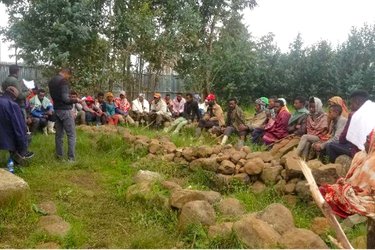

Ethiopia is a land-locked country located in the Horn of Africa. Ethiopia is second populous country with approximately 123 million residents in 2022 and is one of the largest countries in Africa with 1.106 million km2. Ethiopia’s topography is characterized by varied altitudinal and latitudinal regional differences, which endowed the country with an extraordinarily complex climate system.
There is compelling evidence of climate change in Ethiopia over the last 50 years. At the national level, temperatures have increased by an average of around 1°C since the 1960s. Droughts, floods, human and livestock diseases, crop diseases and pests, hailstorms and wildfires are the major climate-related hazards in the country, affecting the livelihoods of significant numbers of people. The country’s adaptive capacity is constrained by limited livelihood options for the majority of the population, inadequate ability to withstand or absorb disasters and the prevailing biophysical shocks it faces.
Ethiopia developed its National Adaptation Plan (NAP-ETH) in 2017 which is complementary to the Climate Resilient Green Economy (CRGE) strategy of the country. As per the Paris agreement, Ethiopia has also updated its NDC and submitted it to the UNFCCC in 2021 with a target a target of achieving net zero emissions by 2050. The updated NDC builds upon several national climate policies and initiatives including the CRGE, the Green Legacy Initiative, and Ethiopia’s 10-Year Development Plan. Fourty adaptation actions with clear baselines & indicators taken from NAP and its implementation roadmap is incorporated in the updated NDC.
A CRGE Facility was established in 2013, overseen by the Ministry of Finance, which is responsible for financial aspects of CRGE implementation. The institutional arrangements reflect a cross-sectoral, multi-disciplinary approach organized through bodies like the inter-ministerial and management committee and allows for regional engagement.
Regardless insignificant contribution Ethiopia has to global greenhouse gas (GHG) emissions which is estimated at 0.04% of global emissions, Ethiopia is taking the lead to fight against climate change impacts and committed to reduce 68.4% of the projected emission of 403.5 Mt CO2eq by 2030. Additionally, to address the climate issue from its root cause, Ethiopia launched the green legacy initiative, and managed to store 10 billion tone carbon from increasing the forest coverage by planting 32 billion seedlings throughout the country that has a significant impact to build resilience and reduce emissions.
In 2019 Ethiopia joined Least Developed Countries (LDC) Initiative for Effective Adaptation and Resilience (LIFE-AR) along other six LDCs countries: Bhutan, Burkina Faso, the Gambia, Malawi and Uganda as the first cohort countries. The prominent reason to join LIFE-AR is to meet both national and international climate change commitments.
In 2023 Ethiopia started the Test and evolve phase and undertook the 4 pilot investments implementation on potable water supply, poultry farm, dairy farm and provision of solar household system. Since the initial official initiative launch in 2022, Ethiopia delivered a number of activities to ensure the implementation of the LDC vision at the national and local levels. Including:
The Ethiopian LIFE-AR initiative has launched four pilot investment activities aimed at enhancing community resilience and promoting climate-resilient development. These include developing potable water supply systems, dairy and poultry farm investments, and providing solar household energy solutions. The expected outcomes encompass general benefits like fostering climate resilience, reducing emissions, and testing LIFE-AR principles for local-level finance delivery. In its establishment phase, LIFE-AR in Ethiopia successfully created institutional arrangements, financial mechanisms, and climate-smart governance structures. The next steps involve refining lessons learned from the pilots, expanding the initiative to three additional kebeles, integrating climate information into development activities, and linking the initiative to the Locally Led Adaptation (LLA) fund for broader implementation.